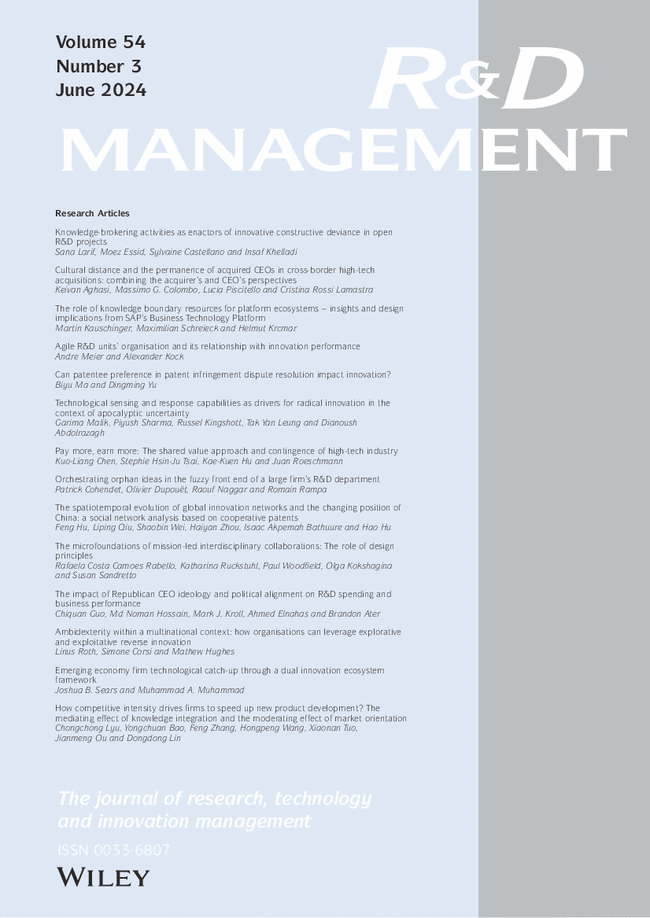Ambidexterity within a multinational context: how organisations can leverage explorative and exploitative reverse innovation
IF 5.7
2区 管理学
Q1 BUSINESS
引用次数: 0
Abstract
Organisational ambidexterity allows firms to maintain a competitive advantage. In today's globally competitive environment, characterised by dispersed knowledge and diversified markets, ambidexterity assumes an even more important connotation from a geographic perspective. In this context, emerging economies (EEs) play a vital role as sources of innovators and market disruptors. This has resulted in the emerging phenomenon of reverse innovation (RI) and the rethinking of firms' multinational R&D and innovation strategies. The present study aims to answer how RI can be incorporated into multinational R&D strategies to bring about organisational ambidexterity on a firm level by balancing explorative and exploitative innovative activities across advanced economies (AEs) and EEs. With primary data collected through semi-structured interviews with thirty R&D executives and senior managers, we find that RI can occur in the form of complete products and smaller innovative contributions toward developing new products that arise from the multinational collaboration between headquarters of organisations, their subsidiaries, and partners. We also find that multinational enterprises use both exploration and exploitation in EEs as the foundation for RI. Finally, we propose four distinct explorative and exploitative RI types that multinational enterprises can pursue to balance their ambidextrous activities across geographies. These four types of innovation are comprised of reverse product innovations and reverse flows of innovative contributions, each of explorative and exploitative nature.跨国背景下的混合灵活性:组织如何利用探索性和开发性逆向创新
组织的灵活性使企业能够保持竞争优势。在当今以知识分散和市场多元化为特点的全球竞争环境中,从地理角度看,灵活性具有更加重要的内涵。在这种情况下,新兴经济体(EEs)作为创新者和市场颠覆者的源泉发挥着至关重要的作用。这导致了新出现的逆向创新(RI)现象,以及对企业跨国研发和创新战略的重新思考。本研究旨在回答如何将反向创新纳入跨国研发战略,通过平衡发达经济体(AEs)和新兴经济体(EEs)之间的探索性和开发性创新活动,在企业层面实现组织的灵活性。通过对 30 位研发主管和高级经理进行半结构化访谈收集的原始数据,我们发现,研发创新可以以完整产品和较小创新贡献的形式出现,这些创新贡献来自于组织总部、其子公司和合作伙伴之间的跨国合作开发的新产品。我们还发现,跨国企业将企业外部环境中的探索和开发作为 RI 的基础。最后,我们提出了四种不同的探索性和开发性创新类型,跨国企业可以通过这些类型来平衡其跨地域的灵活活动。这四种创新类型包括逆向产品创新和逆向创新贡献流,每种类型都具有探索和开发性质。
本文章由计算机程序翻译,如有差异,请以英文原文为准。
求助全文
约1分钟内获得全文
求助全文
来源期刊

R&D Management
Multiple-
CiteScore
11.30
自引率
9.50%
发文量
0
期刊介绍:
R&D Management journal publishes articles which address the interests of both practising managers and academic researchers in research and development and innovation management. Covering the full range of topics in research, development, design and innovation, and related strategic and human resource issues - from exploratory science to commercial exploitation - articles also examine social, economic and environmental implications.
 求助内容:
求助内容: 应助结果提醒方式:
应助结果提醒方式:


